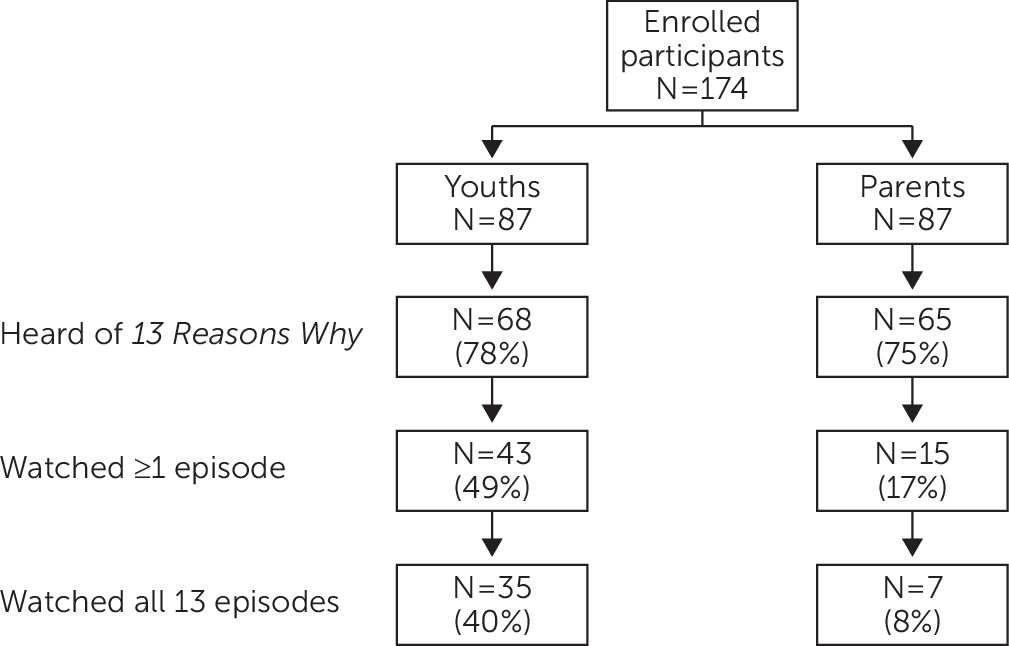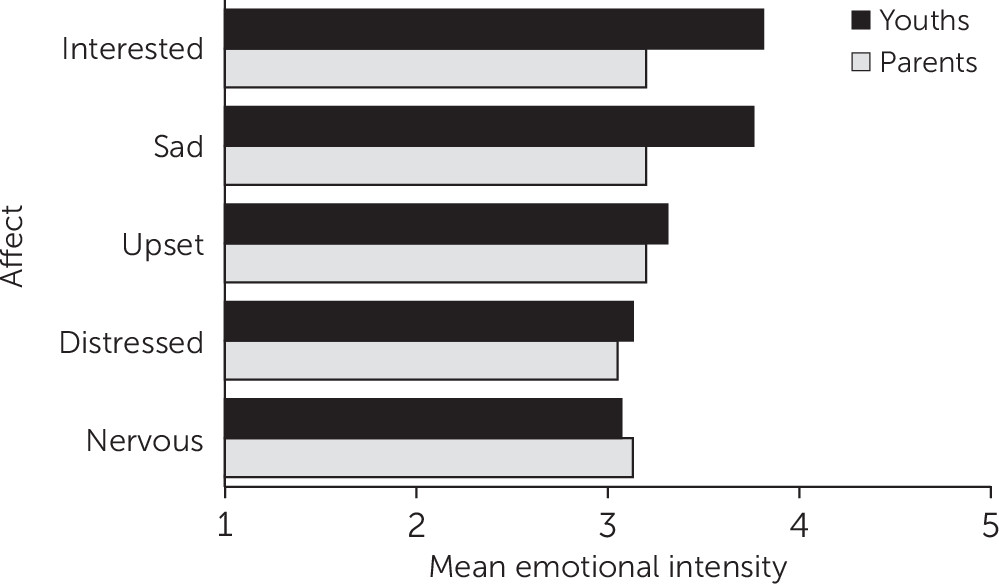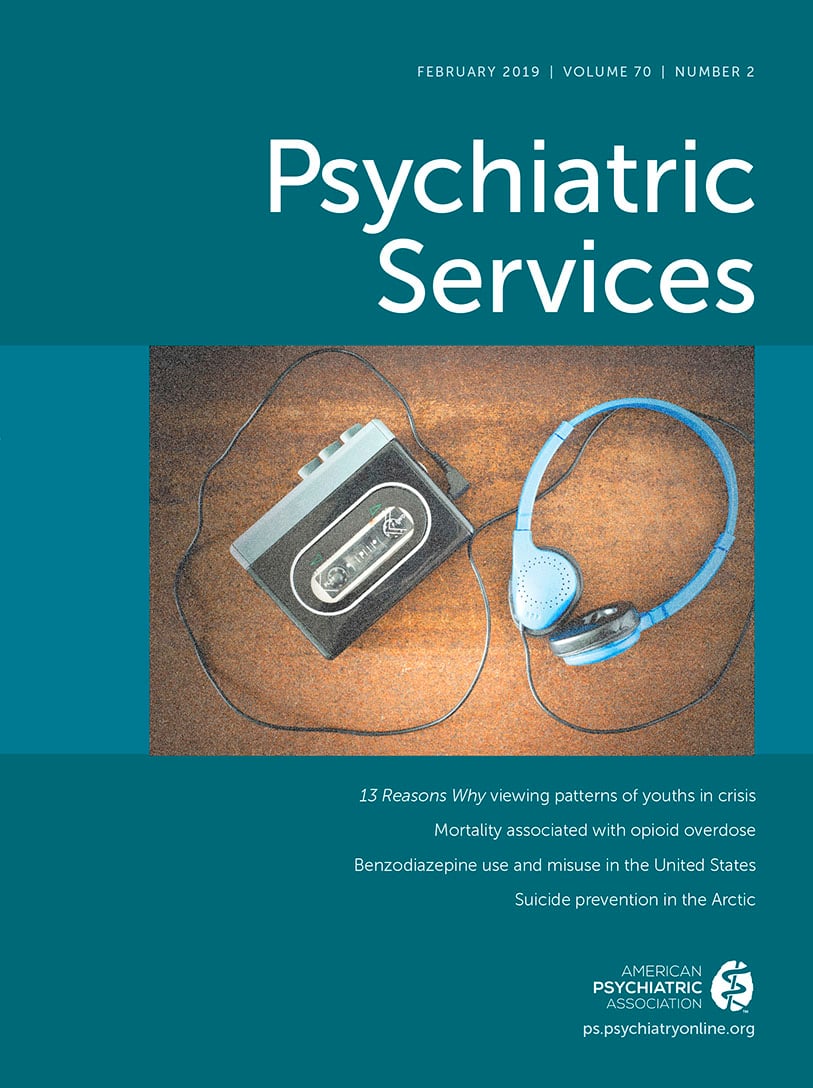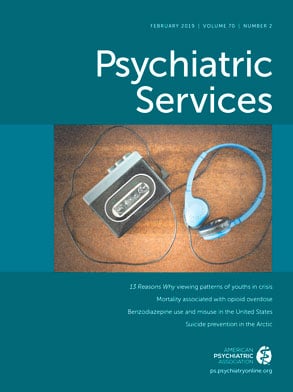The Netflix series
13 Reasons Why, a recounting of 13 reasons why a high school student chose to die by suicide, was released in March 2017 and has proven both popular and controversial. In 2017, Google searches about the show in the United States exceeded those for any other television or streaming series (trends.google.com/trends/yis/2017/US). The series has generated significant discussion among parents, teachers, youths, and the suicide prevention community because of its handling of the topic of teen suicide and its graphic depiction of suicide and sexual assault (
1). Some argue that the show glorifies suicide and could negatively influence vulnerable youths, whereas others believe that the series sheds light on important topics, thereby increasing awareness and promoting conversations about the reality of life in high school (
2–
4). Some have recommended that vulnerable youths avoid the series or that Netflix cancel the series (
5,
6). Criticism includes assertions that the producers did not adhere to media guidelines about suicide, citing the evidence regarding suicide contagion (
7–
11). Notably, these concerns exist in the context of the rapid rise in suicide rates for youths in the United States, most significantly among adolescent girls (
12).
In the days following the release of
13 Reasons Why, season 1, suicide-related Internet searches increased markedly, with searches of how to “commit suicide” increasing by 26%. This phenomenon was balanced by an increase of 21% in searches for suicide hotline numbers and an increase of 26% in searches for suicide prevention (
13). Anecdotal examples of youths engaging in suicidal and self-harm behavior, citing the series as an influence, heightened the concern of health professionals, parents, and educators (
14,
15). Following the release of season 1, there were also reports of increases in the volume of youths presenting to emergency departments (EDs) with suicide-related concerns (
16,
17). In an effort to inform and educate, several national agencies, including the American Psychiatric Association, the American Foundation for Suicide Prevention, and the Suicide Prevention Resource Center, responded by distributing talking points about the series (
18–
22).
A study of a community sample of adolescents ages 13 to 22 from four global regions, including the United States, was commissioned by Netflix to explore reactions to the series (
23). The majority (71%) of participants in the U.S. sample reported talking to their parents about the series and related issues, supporting the producers’ hopes that the series would promote parent-child conversations about difficult topics such as suicide (
2). The survey revealed other benefits from watching the series—for instance, half of the respondents reported having apologized to someone for past mistreatment. Notably, however, 43% of viewers disagreed with the statement, “The way the suicide was depicted was appropriate for me personally,” and 33% reported that the content was too graphic. Younger viewers and those with higher social anxiety were especially sensitive to the intensity of the suicide and sexual assault scenes (
23). Because this study’s respondents were from a general population sample, the study did not address the concern that certain subgroups of youths might be particularly vulnerable to the series’ content.
Decades of research have substantiated the potentially detrimental impact of exposure to violent media images or content among children and youths. Concerns about contagion as a result of media exposure to suicide dates back to the Werther effect, first documented in 1774. Gould (
24) highlighted the significant relationship between media coverage and subsequent suicides, with the impact being most notable among youths. The vast literature on relationships between media and youth violence also points to possible pathways by which media exposure can affect youth behavior. Violent media images may precipitate youth aggression via modeling, increased emotionality while viewing disturbing content, alterations in attitudes and beliefs about the acceptability of violence, and desensitization (
25). Certain youth characteristics (e.g., gender, pre-existing aggressive behavior, mental illness, and family context) may convey additional vulnerability to media exposure. Youth identification with characters who perpetrate violence, or in the case of
13 Reasons Why, identification with characters who self-harm, is also thought to be an important influencing factor. In some cases, the viewers’ identification with a fictional character is so strong that they conflate the character’s experiences with their own, with affective, cognitive, and, most concerning, behavioral consequences (
26,
27).
This study was designed to explore exposure, including viewing patterns, to 13 Reasons Why in a sample of youths seeking care at a psychiatric ED for suicide-related risk. The study also examined the perceived impact of the show on participants who reported having watched at least one episode. We expected that vulnerable youths, struggling with suicidal thinking and behavior, would strongly identify with the main female character, Hannah, and that greater identification would be correlated with increased emotional distress and suicide risk. We were also interested in exploring parents’ reactions to the series and the extent to which they were able to provide support to their children post viewing.
Methods
Participants and Procedures
Study participants were 87 youths (mean±SD age=14.6±1.8) and 87 parents or legal guardians who presented to a psychiatric ED between July 2017 and March 2018. Youths were eligible for the study if they were between the ages of 10 and 17 and presented with a suicide-related concern. Exclusion criteria included being non-English speaking; demonstrating psychosis, current intoxication, cognitive impairment, or severe aggression or agitation; and being unaccompanied by a legal guardian.
Table 1 provides details about the sample. Youth assent and parent or legal guardian consent were obtained from all participants. Of the 186 families approached to participate in the study, 90 (48%) provided consent and assent. Three participants with incomplete responses were excluded from data analyses. The survey was included as part of a larger study, titled “Psychiatric Emergency Services Family Support and Follow-Up.” Youths and parents were remunerated for participation with a $10 and $5 incentive, respectively. The study was approved by the institutional review board at the University of Michigan.
Measures
Parents and youths completed a battery of self-report measures during their ED visit. The Reynolds Adolescent Depression Scale, second edition (RADS-2), was used to assess the severity of youths’ depressive symptoms (
28). Current suicidal ideation was measured with the Suicidal Ideation Questionnaire–Junior (SIQ-JR) (
29). SIQ-JR total scores of psychiatrically hospitalized adolescents have been found to be significant predictors of suicidal thoughts and suicide attempts 6 months after hospital discharge (
30).
Youth Questionnaire
We developed a 44-item questionnaire to assess several aspects of youths’ interactions with
13 Reasons Why, using caution to avoid advertising the series to youths who were not already aware of it. We first inquired whether youths had access to online streaming platforms; youths who replied no were not asked any additional questions. Similarly, youths who reported not having heard of the show were not asked any additional questions. Consistent with guidelines for measuring children’s media consumption (
31), the questionnaire includes quantitative and qualitative items assessing access to and awareness of the series, number of episodes watched, viewership timeline, reasons for watching (or stopping) the series, how youths viewed the series (e.g., alone, with parents, with siblings, or with friends), and with whom youths discussed the series (e.g., friends, parents, no one, a teacher, or a mental health professional). The Positive and Negative Affect Schedule (PANAS) (
32) was used to assess youths’ emotional responses to the series (e.g., interested, distressed, scared, and sad). This self-report scale uses a 5-point Likert scale to assess the intensity of 20 emotional responses to watching the series, with responses ranging from very slightly or not at all to extremely. Scores were summed for composite positive (α=.80) and negative (α=.94) affect scores, with possible scores ranging from 20 to 100. Higher scores indicate increased affect.
Youths were also asked to indicate how much they identified with the male and female lead characters on a Likert scale. Two items were included to evaluate perceptions of whether the series’ had an impact on the youth’s own suicide risk and on the likelihood of engaging in support-seeking behaviors. The responses were scored on a 5-point Likert scale, ranging from 1 (not at all) to 5 (yes, absolutely) for the suicide risk item and from 1 (less likely) to 5 (more likely) for the support-seeking behavior item. Finally, open-ended questions were used to ask youths to reflect on their viewing experience, comment on the emotional impact of the series, and share their beliefs on whether the series glorified or normalized suicide.
Parent Questionnaire
The 36-item parent measure is similar to the youth survey and assesses access to and awareness of the series, number of episodes watched, awareness of the child’s exposure to the series, receipt of content warnings about the series, extent of conversations with the child about the series, and perceived readiness to discuss the series with the child. Identical PANAS (
32) items were included to assess parents’ positive (α=.86) and negative (α=.87) emotional responses to the series. Finally, parents were asked to respond to three open-ended questions regarding the conversations they had with the child about the series, their own emotional reaction to the series, and their reflections on their decision to deny or allow the child access to the series.
Data Analysis
Descriptive analyses were conducted to characterize participating families in terms of demographic characteristics, severity of youths’ depressive symptoms, and youths’ suicidal ideation. Further analyses depict youths’ and parents’ patterns of viewership and the perceived impact of viewing the series. Pearson correlations and t tests were used to evaluate emotional responses while watching the show and the show’s perceived impact.
Qualitative data were analyzed by using an iterative grounded theory approach (
33). Open-ended responses were systematically organized into emerging themes (i.e., categories) and then independently coded by two trained coders. Responses that were irrelevant to the survey question were excluded from the analyses. Coding was compared for agreement between the two coders. A consensus on a statement’s theme was agreed upon collaboratively. As described by Miles and Huberman (
34), interrater reliability (IRR) was calculated by dividing the number of items of agreement by the sum of all items. The IRR was 86% for the parent qualitative data and 97% for the youth qualitative data.
Results
Youth Clinical Characteristics
In the youth sample, the mean±SD SIQ-JR score was 49.26±24.32 (range 0–90). Nearly three-quarters of youths (N=65) reported scores within the clinical range (defined as a score of ≥31). The mean RADS score was 96.60±14.60 (range 41–123), with 78 youths (90%) scoring in the clinical range for depressive symptoms (defined as a score of ≥76).
Youths who completed the entire season (i.e., watched all 13 episodes) were compared with those who did not (i.e., watched <13 episodes or none at all). The groups did not differ in terms of gender, severity of suicidal ideation, or depressive symptoms. Youths who viewed the entire season were significantly older than those who did not watch or did not complete the series (t=−2.04, df=84, p=0.045).
Exposure
Of the youth sample, 79 (91%) had access to the program via online streaming services.
Figure 1 depicts exposure to
13 Reasons Why among youths and parents. Of the youths who watched the series, 73% (N=32) reported that they watched it because others were talking about it at school, 64% (N=28) said that their friends or siblings watched it, and 57% (N=25) saw it promoted on Netflix. When asked if they had been exposed to information alerting them to concerns about the show’s content, most parents indicated that they had not received such warnings either via news (N=58, 67%) or by their child’s school (N=58, 70%). Most parents (N=39, 91%) whose children watched all or part of the series were aware that their child had watched it.
Viewing Context
On average, youths took approximately 16 days to complete the 13-episode season. Most youths who watched any episodes of
13 Reasons Why reported doing so alone (N=37, 84%). Other youths reported watching the series with friends or siblings (N=8, 18%) or with their parents (N=2, 5%). Whereas 80% (N=35) of youth viewers reported talking to their friends about the series, only 34% (N=15) discussed their reactions with a parent and 16% (N=7) did not discuss their reactions with anyone. One youth indicated talking about the series with a teacher or school counselor, and no youths reported discussing the series with a mental health professional. A third of parents (N=14, 33%) expressed that they would feel or felt unprepared to some degree to discuss the series with their child (mean score
=2.98±1.66 out of 5, with 1 indicating not prepared and 5 indicating very prepared). Qualitative data from the
13 Reasons Why parent questionnaire were also analyzed; 27 parents responded to the question, “If you had a conversation with your child about the show, what did you focus on?” Of the 27 parents who had a conversation with their child about the series, about a quarter (N=7) discussed the topic of suicide. Themes emerging from these data are summarized in
Table 2.
Perceptions of the Show’s Impact and Emotional Reactions to the Show
Youths reported mixed perceptions about the impact of viewing the series on their risk of suicide. Of the 41 youths who responded to this question, 51% of viewers (N=21) indicated that they believed watching the series increased their own risk of suicide to some degree. The majority of youths who viewed 13 Reasons Why reported identifying with at least one of the lead characters, Hannah (N=40) and Clay (N=37), to a nonzero degree. Identification was measured by using a 10-point Likert scale, with 1 being “not at all” and 10 being “completely.” Overall, youths reported moderate identification with Hannah (5.74±2.66) and Clay (5.12±2.88). Identification with Hannah was significantly correlated with the perception that the series increased one’s risk of suicide (r=.63, df=41, p<0.001). Identification with Clay was correlated at a trend level with the perception that the series increased one’s risk of suicide (r=.31, df=41, p=0.052).
On the basis of PANAS results, emotional responses to the series were scored by negative affect (N=39, mean=36.28±15.13, range 14–66) and positive affect (N=40, mean=20.93±7.44, range 10–36).
Figure 2 illustrates the top five affective responses to the series as reported by youth and parents. Youths who reported experiencing increased negative affect while watching the series were more likely to identify with Hannah (r=.61, df=38, p<0.001) and Clay (r=.37, df=47, p=0.023). Youths who reported experiencing any increase in affect while watching the series were more likely to perceive that the series increased their risk of suicide (r=.72, df=37, p<0.001) and to identify with Hannah (r=.57, df=38, p<0.001) and Clay (r=.42, df=37, p=0.028).
Youth Vulnerability and Perceptions of Impact
Identification with Hannah was significantly correlated with higher suicidal ideation (r=.47, df=43, p=0.001) and depressive symptoms (r=.43, df=43, p=0.004). Identification with Clay was not correlated with symptom severity.
Qualitative data from the
13 Reasons Why youth questionnaire were analyzed. Forty youths responded to the question, “Some professionals have expressed concerns that
13 Reasons Why glorifies or normalizes suicide. What are your opinions about this?” Overall, youths expressed more positive than negative opinions about the series, but the number of youths who believed that the series glorifies or normalizes suicide was equal to the number who believed the reverse (i.e., the series does not glorify or normalize suicide). Themes emerging from these data are summarized in
Table 3.
Perceptions of Impact on Help Seeking
Data also reflected mixed perceptions about the series’ impact on whether youths contacted someone about their personal mental health concerns (support-seeking behavior). Eighteen of the youths who watched all or part of the series (42%) indicated that the series had no impact on whether they talked to others about their concerns (mean=2.95±1.21). However, 12 youths (28%) reported that the series made them less likely to talk to others, whereas 12 others (28%) reported that it made them more likely to talk to others. Youths who reported that watching the show made them more likely to talk about their mental health concerns were more likely to believe that the show did not increase their risk of suicide (r=–.33, df=40, p=0.04).
Discussion
13 Reasons Why was widely known by our study sample of youths presenting to a psychiatric ED with suicide-related concerns. A substantial number of these youths had watched the series, and the majority had watched it alone. It is unclear what percentage of youths in the general population watched the series, although that would be useful as a comparison. Only about a third of youths in this study’s sample reported having talked with a parent about the series, and the idea that watching it would prompt conversation between youths and parents was not supported by these results.
These findings are particularly notable compared with the results of the Netflix-commissioned international survey (
23), in which 71% of youths in a community sample reported having talked to a parent about the series. This could indicate some differences in the ability or desire of youths at high risk of suicide to have discussions with their parents around challenging topics. That is consistent with studies that have found significant rates of parental psychopathology, parent-child attachment concerns, and family conflict among youths at risk of suicide (
35,
36). Thus, for a variety of reasons, youths who are in greatest need of adult support may be less likely to seek it out. Over 80% of youth viewers in this sample reported talking to their friends about the series, which is consistent with the international survey results as well as previous studies on patterns of help seeking among suicidal youths. These results support the need for peer education, trained peer support services, and gatekeeper training in suicide prevention for young people (
23,
37).
About half of the youth viewers reported that watching 13 Reasons Why increased their suicide risk to a nonzero degree. Given that any increase in suicide risk is significant, this finding warrants further exploration of the potential mechanisms of influence. The sample reported significant levels of identification with the main female character, which would be expected given that they are similar in age and share the common factor of suicidal ideation. Stronger identification with the main female character was positively correlated with the perception that watching the series increased one’s suicide risk, highlighting how specific, highly relatable characters—in this case one who dies by suicide—may influence vulnerable viewers.
Many of the youths in this sample reported a high degree of affective response to the series, and those who did were more likely to perceive an increased risk of suicide related to viewing the series, as well as to strongly identify with the lead characters. This is particularly relevant when considering the evidence for the positive correlation between emotional reactivity and suicidal ideation (
38). Concern about the potentially volatile mixture of the emotionally charged content of the series, its highly relatable main characters, and the characteristics of youth viewers in the sample seems warranted.
Very few parents in this sample watched the series, and some were unaware that their child had watched it, highlighting the importance of being aware of a child’s media consumption. The majority of parents in our study indicated a low level of perceived preparedness to discuss the topics raised by the series with their children, and most had not been warned about the series’ content. These issues are highlighted in a recent toolkit (
www.13reasonswhytoolkit.org) developed by mental health experts regarding season 2 of
13 Reasons Why. The toolkit recommends that parents watch the series with their child, monitor the reactions of particularly vulnerable children, and talk with them about the series. In addition to providing enhanced support for parents, the toolkit provides guidance for youths, educators, clinicians, and the media itself. Clinicians are advised to educate themselves about the show and the topics raised, provide viewing guidance to at-risk youths, advocate for responsible journalism, and promote help seeking and self-care among at-risk youths. Members of the media are encouraged to avoid sensationalizing suicide or violence, always provide access to crisis resources such as the Suicide Prevention Lifeline (1-800-273-TALK), include messages of hope and recovery, and be sure to present factual information.
Netflix added further content warnings for season 2, including direct statements that the series may not be appropriate for certain viewers and guidelines about how to watch safely and get help if one has suicidal thoughts (
39). Despite the controversy surrounding the series, there have been some positive responses; for example, at one high school, students initiated a project entitled “13 Reasons Why Not” (
40).
This study had several limitations that should be considered. The sample was mostly Caucasian and female and was recruited from a single site, limiting the generalizability of findings to a broader population. The surveys were developed for this study and, as such, its psychometric properties were not previously established. The study’s relatively small sample size may have limited the statistical power for some comparisons. There were also limitations inherent to using survey methodology, including inconsistency in understanding the questions and inaccurate responses by participants. There was potential for recall bias, given that a significant amount of time may have passed between watching the series and completion of the survey. The specific survey question asking about the effect of watching the series on suicide risk does not include an option for potential reduction of suicide risk, eliminating the inclusion of that outcome in the data. Although the depiction of sexual assault as a triggering aspect of the series is a concern, this study did not include reliable data on the history of sexual assault among the study participants. Finally, all of the youths in the sample were at elevated suicide risk, and as a result, a comparison sample of healthy youths was not available.
Conclusions
Despite the widespread controversy and speculation about the potential effects of
13 Reasons Why, season 1, on vulnerable youths, this is the first study examining exposure to the series in a sample at high risk of suicide. Our results support the need for tailored prevention programming for vulnerable youths, education and training for their parents regarding youth suicide, and peer- focused interventions (
41,
42). For certain youths, watching the series correlated with a perceived nonzero elevation in their suicide risk; identification with the main female character and strong affective reactions may be markers of increased risk associated with viewing the show. Collaboration between producers of various media with mental health experts is crucial in mitigating the negative impact of portrayals of suicide on vulnerable youths. Future research is needed, concentrating on how media content, particularly content that focuses on youth suicide, can influence the mental health and suicide risk of its viewers.
Acknowledgments
The authors thank Corey Jackson, M.S., Eskira Kahsay, B.A., Gigi Colombini, L.M.S.W., John Kettley, L.M.S.W., Karlin Stern, B.A., Devyn Masterson, B.A., ED staff, and the youth and family participants.



